Introduction
| |
|
| |
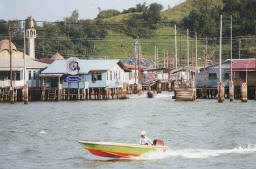 |
| |
The Water Village in the heart
of
Bandar Seri Begawan. |
| |
|
Many visitors to the Bruneian capital of Bandar Seri
Begawan will hire a speedboat from the waterfront to take a closer look at
the Kampung Ayer or Water Village which has existed on the Sungei Brunei
(Brunei River) for centuries. However, just 5 minutes downriver are
mangroves which have existed for millions of years. These mangroves extend
to the mouth of the Brunei River 10 km downstream, where they merge with the
extensive mudflats and mangroves of the Limbang River which drains from the
heart of Sarawak. This is the favoured home of Borneo's famous Proboscis
Monkey.
Mudflats and Mangroves
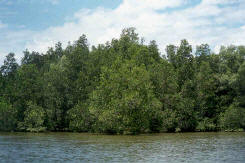 |
|
|
Rhizophora sp. are the
dominant mangroves of Brunei Bay. |
|
| |
|
The term "mangroves" is used to embrace various tree
species which have become adapted to life in a marine or brackish
environment - they are able to withstand various degrees of immersion in
saltwater which would normally kill other tree and plant species. They are
generally associated with muddy river mouths where sediment deposition
advances seaward; the pioneer mangrove species serve to stabilise the
mudflats and prevent coastal erosion. The effects of varying water depth and
tides creates a complex zonation where different parts of the mudflats are
dominated by single species of mangrove.
| |
|
| |
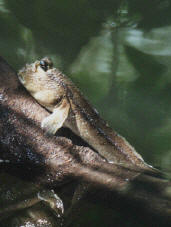 |
| |
A Giant Mudskipper clings to a
mangrove root. |
| |
|
The mangroves of Brunei Bay are largely dominated by
Rhizophora sp. - a tree species characterised by prop roots or stilt roots
which provide a stable base in the soft mud. In many parts of Southeast Asia
this species has been constantly harvested for its young trunks, which have
the properties of strength and durability - the wood is known as Bakau and
it has widespread uses. (During construction many tall buildings in places
such as Singapore or Kuala Lumpur will have used Bakau as scaffolding).
However, there appears to have been little harvesting of this mangrove
species in Brunei Bay and the ecosystem appears to be largely intact.
During low-tide, the Giant Mudskipper (Periophthalmodon
schlosseri) emerges. Mudskippers represent an evolutionary missing-link;
they are fish which spend at least half of their lives out of the water in
the manner of amphibians. Their eyes are located on top of the head,
allowing them to keep a close eye on their territory. Disputes and fights
between rival mudskippers are a common occurrence !
On Pulau Selirong (Selirong Island), about 30 minutes
boat ride from town, there is a 3 km boardwalk where visitors can view the
mangrove ecosystem without getting wet feet or stuck in the mud.
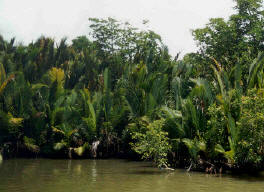 |
|
|
The attractive fronds of Nipah
dominate the quiet backwaters of the mangrove estuary. |
|
| |
|
Nipah
In the calmer backwaters of Brunei Bay the margins of
the mangrove forests are fringed with Nipah (Nypa fruticans), an attractive,
widespread species with tall palm-like fronds and distinctive, bunched,
nut-like fruits. Again, this species has many traditional uses - dried
leaves are used for roofing material, and the seeds are edible, finding
their way into a variety of Southeast Asian desserts. As with the mangroves,
the Nipah of Sungei Brunei are in fine condition, with little evidence of
harvesting.
The Wild Dutchman of Borneo
| |
|
| |
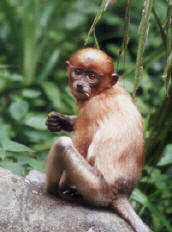 |
| |
Proboscis Monkey, immature |
| |
|
Coastal swamps and mangroves are the favoured haunt of
the Proboscis or Long-nose Monkey (Nasalis larvatus), a species endemic to
Borneo. In neighboring Kalimantan, the Indonesian administered part of
Borneo, this monkey is amusingly called Orang Belanda, which translates as
"Man from Holland" - on account of the male monkey's remarkably long nose
and large belly. One wonders what the species was called before the arrival
of the Dutch to the East Indies four hundred years ago !
Besides the distinctive nose of the male, the
Proboscis Monkey is characterised by having a long pale coloured tail. The
body fur is a light orange-brown and some males have a thick, lighter
coloured fur around the collar. These monkeys rarely come down to the
ground, preferring to spend their time high in the mangroves, however they
are rather good swimmers which enables them to colonize new mangrove growth
on seaward mudbanks. The best time to view the
monkeys is either at sunrise, or at late afternoon when they become active.
Listen out for the variety of loud calls and grunts of the male as it tries
to persuade females to come and view its attractive nose. Troops of monkeys
can be found fairly easily, especially at the mouth of Sungei Brunei and on
Pulau Ranggu, accessible by boat from Bandar Seri Begawan. |